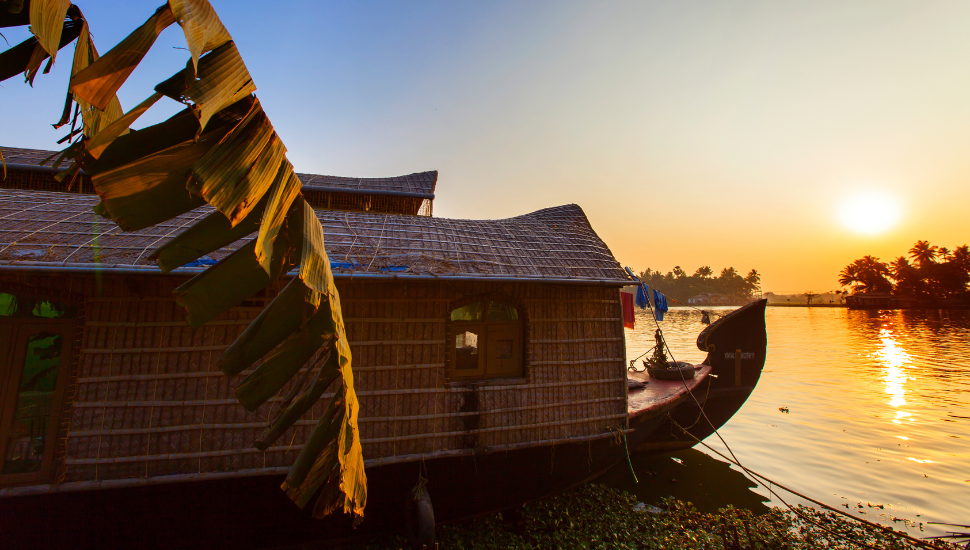Explore the Backwaters of Kerala: Complete Guide
Ply the dreamy palm-fringed waterways of Alleppey (Alappuzha) and experience one of the most relaxing areas in all of India.
Set in the hinterland of Kerala's Malabar Coast, these canals connect five large lakes, themselves fed by 38 rivers.
While the prime function of the waterways is to aid the transport of rice to Alleppey and beyond, they also support a thriving tourist industry of boat cruises and houseboat stays.
Houseboat Stays in the Kerala Backwaters
Indeed, enjoying an overnight stay on a houseboat comes highly recommended, as it allows you to wake up to the sights and sounds of nature on the river as the dawn breaks in a flourish of pinks and oranges. The waterways are home to a vast amount of nature, including cormorants, woodpeckers, bee-eaters, macaques, sloth bears, and elephants.
You'll also witness the economic and cultural life of the river - from canoe-borne fishermen casting their nets, to little markets selling fresh produce.
Houseboats are often well-appointed and often come with staff who will organise delicious local cuisine.
They invariably feature areas where you can sit and watch river life unfold.
Kerala 'Backwaters' Explained
The term 'backwaters' might not seem like the most alluring of word choices for these stunning riverside communities, but it has become synonymous with waterborne, nature-filled adventure when used in conjunction with 'Kerala.'
There are 34 'backwaters' in Kerala, many of them in the area east of Alleppey. Indeed, when people talk of 'the Kerala backwaters,' they are likely referring to this particular web of canals.

Canoe Tours
If you’re fit and willing, a canoe tour is a great way to see the waterways in a more intimate, environmentally conscious way (not least because you won’t be emitting diesel fumes).
Full day canoe/kayak tours are available, departing Alleppey. This option allows you to experience village life and food more easily, as well giving you a real sense of adventure.
When to Visit the Kerala Backwaters
Visit between October and March (the dry winter season) to experience temperatures of between 20 and 32 degrees and minimal rainfall. This makes boat rides more comfortable.
December to January, while offering pleasant temperatures and low precipitation, also attracts many local holidaymakers, making accommodation more difficult to come by.
It's best to avoid the peak of the monsoon - June to August - since torrential rains and flooding are widespread.

How to Book Kerala Houseboats and Other Accommodation
Websites such as Booking and Airbnb list a choice of static houseboats (alongside touring houseboats - see below). These cost from £60-£150, depending on dates and comfort level.
Such prices can seem rather high given the otherwise affordable rates offered by hotels in India, but the area is increasingly popular - both among locals and overseas visitors.
Many other accommodation types are available, including waterside resorts with wooden verandas that give you ringside views of river life. These are generally cheaper than houseboat stays.
If you're on a budget, consider one or two nights on a houseboat, and the remainder of your stay in a land-based guesthouse or hotel.
Should You Take a Houseboat Tour?
It's also possible to stay on a houseboat that moves between key attractions in the canal system (or simply begins and ends in Alleppey). These dock overnight (local laws stipulate engines must be off by sundown, helping to preserve the peace and tranquility of the backwaters).
These tours include meals and service and are considered one of the best travel experiences in India.
However, some travellers are reluctant to take a houseboat tour because they believe the waves caused by these large boats disrupt smaller vessels, while creating noise and fumes. There is also concern that their poor waste management impacts local communities who use the river to bathe, cook, and fish in. A houseboat tour will also be more costly than moving around by smaller ferries and staying in guest houses, homestays, hotels, or moored houseboats (arguably more sustainable options).
However, the houseboat tour industry does employ many locals.

How to Reach the Kerala Backwaters
Air India runs direct flights from Gatwick to Kochi (Cochin) - Kerala's capital (9h 50). Indirect flights can take several hours longer, with changes in cities such as Dubai or Mumbai.
Once in Kochi, you can travel south to Alleppey by road (taxi or hire car), train, or bus (78km). There is also a ferry from Fort Kochi to Alleppey (up to 370 rupees/£3.50).
Inexpensive ferries can help you get around once in Alleppey and the waterway system.
Kollam to Alleppey by Government Ferry
If you find yourself in Kollam (to the south of Alleppey) before entering the backwaters, know there is a daily government ferry service to Alleppey, departing Kollam's DTPC Jetty at 10.30am.
This takes an arduous 8 hours but only costs Rs 600 per person (£3.10).
Attractions in and Around Alleppey
Key attractions in and around Alleppey and its waterways include:
- Kalloorkad St Mary's Basilica - an ancient Christian church believed to have been established in AD 427. Located by the water.
- Sree Krishna Swamy Temple - this charming 13th-century Hindu temple and monastery are also located on a waterway.
- Beaches - Alleppey Beach is a chief highlight of Alleppey. Nearby Marari Beach offers even more seclusion. You can visit these before or after your time in the backwaters.

What's the Food Like in the Kerala Backwaters?
Fresh fish and seafood are served across the Kerala Backwaters, usually prepared in a spicy pollichathu style - with curry leaves, onions, lime juice, garlic, ginger, and spices. It is often fried.
Crabs and prawns are also found in abundance.
Appams (rice flour and coconut milk bread) and dosas (fermented rice and gram flour bread) are often served for breakfast crepe-style, usually accompanied by vegetable curry or sambar (lentils and vegetable stew). Idli (rice cakes) are also common, plated up with chutneys or lentil stews.
Get a Quote